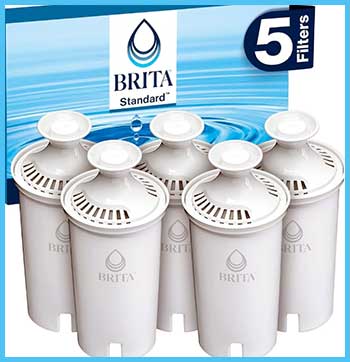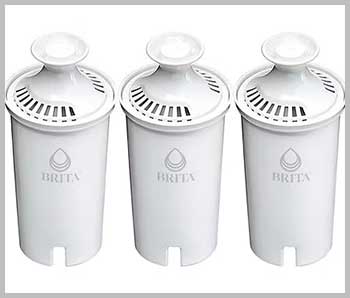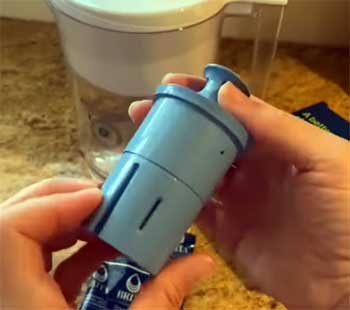I’ve been using Brita pitchers for years, always trusting them to make my tap water taste better. But when I heard about the Brita Elite filter, I wondered if it was worth upgrading from the Standard filter I’d relied on.
In this article, I’ll compare the Brita Elite (sometimes called Brita Plus or Longlast) and Standard filters, breaking down their features, pros, cons, and performance. My goal is to help you decide which filter suits your needs, whether you’re after cleaner water, longer-lasting filters, or budget-friendly options.
Let’s explore what makes these filters tick and which one comes out on top.
A Brief Comparison Table
| Feature | Brita Elite Filter | Brita Standard Filter |
| Lifespan | 6 months or 120 gallons | 2 months or 40 gallons |
| Contaminant Removal | Chlorine, lead, mercury, cadmium, benzene, asbestos, Class I particulates (0.5-1.0 micron) | Chlorine, mercury, cadmium, copper, zinc |
| Presoak Required | No | Yes (15-20 minutes) |
| Filter Color | Pale blue | White |
| Cost per Filter | ~$16.50 (varies by pack size) | ~$4.17 (varies by pack size) |
| Annual Cost (est.) | ~$33 (2 filters/year) | ~$25 (6 filters/year) |
| Recyclability | Yes (via TerraCycle) | Yes (via TerraCycle) |
| Certifications | NSF/ANSI 42, 53, 401 (for lead, PFOA/PFOS) | NSF/ANSI 42 |
| Filter Media | Activated carbon, proprietary pleated media | Activated carbon, ion exchange resin, mesh screen |
Why I Started Comparing These Filters?
Like many of you, I started with the Brita Standard filter because it came with my pitcher. It did a decent job of making my tap water taste less like a swimming pool, but I kept hearing about the Elite filter’s superior performance and longer lifespan.
I was tired of replacing filters every two months, and the idea of a filter that could tackle more contaminants—like lead—caught my attention. So, I decided to test both filters in my Brita Tahoe pitcher, paying close attention to taste, ease of use, and overall value.
Here’s what I found after months of use and research.
Key Features of The Brita Standard Filter
The Brita Standard filter is the workhorse of Brita’s lineup. It’s been around forever, and it’s what most people picture when they think of a Brita filter. Here’s what it brings to the table:

- Contaminant Removal: The Standard filter targets chlorine (taste and odor), mercury, cadmium, copper, and zinc. It’s designed to improve water taste and reduce common metals found in tap water.
- Lifespan: It lasts about 2 months or 40 gallons, whichever comes first. For a household like mine (two people, moderate water use), this meant replacing it every 6-8 weeks.
- Setup: You need to soak it in water for 15-20 minutes before use, which can feel like a chore if you’re impatient like me.
- Cost: At around $4-5 per filter when bought in bulk, it’s budget-friendly. Over a year, I’d spend about $25 replacing filters six times.
- Design: It’s white, fits all standard Brita pitchers (except Stream models), and uses a combination of activated carbon granules, ion exchange resin, and a mesh screen to filter water.
I found the Standard filter reliable for basic needs. My tap water in a mid-sized city has a slight chlorine taste, and this filter made it crisp and clean. It also reduced limescale buildup in my kettle, which was a nice bonus.
However, I noticed it didn’t do much for the occasional metallic aftertaste in my water, and I wondered if it was missing some contaminants.
Pros And Cons of The Brita Standard Filter
Pros
- Affordable Upfront Cost: At $4-5 per filter, it’s easy on the wallet, especially if you buy multipacks.
- Effective for Basic Needs: It reliably removes chlorine, making water taste and smell better. It also reduces copper, zinc, and mercury, which improves water quality in many municipal systems.
- Widely Available: You can find Standard filters at almost any grocery store or online retailer.
- Recyclable: Brita partners with TerraCycle to recycle used filters, which eased my eco-conscious guilt.
- Fits All Standard Pitchers: Interchangeable with the Elite, so you don’t need a new pitcher to try it.
Cons
- Limited Contaminant Removal: It doesn’t tackle lead, benzene, or asbestos, which can be present in some tap water, especially in older homes or industrial areas.
- Short Lifespan: Replacing it every 2 months gets old fast, especially if you use a lot of water.
- Presoak Hassle: The 15-20 minute soak feels unnecessary when you’re just trying to get clean water.
- Less Effective Over Time: After about 6 weeks, I noticed the water taste wasn’t as crisp, suggesting the filter was losing effectiveness.
Key Features of The Brita Elite Filter
The Brita Elite filter (formerly called Longlast) is marketed as the upgraded version, promising more robust filtration and a longer lifespan. Here’s what stands out:

- Contaminant Removal: It tackles chlorine, lead, mercury, cadmium, benzene, asbestos, and Class I particulates (0.5-1.0 micron). It’s certified to reduce lead and even some PFAS (like PFOA/PFOS), which are nasty chemicals linked to health risks.
- Lifespan: Lasts up to 6 months or 120 gallons—three times longer than the Standard. For me, this meant just two replacements a year, which was a game-changer.
- Setup: No presoak needed. You pop it in, fill the pitcher, and you’re good to go in minutes.
- Cost: Pricier at about $16-17 per filter, but you only need two a year, so the annual cost is around $33.
- Design: Pale blue, it fits the same Brita pitchers as the Standard (except Stream). It uses activated carbon and proprietary pleated media, which Brita claims enhances filtration.
Using the Elite filter, I noticed a cleaner, almost bottled-water-like taste. My coffee and tea tasted better, and I felt more confident knowing it was tackling lead, which is a concern in older homes like mine with aging pipes. The longer lifespan also meant less hassle, which I appreciated.
Pros And Cons of The Brita Elite Filter
Pros
- Broader Contaminant Removal: It handles lead, benzene, asbestos, and PFAS, making it a safer bet for those concerned about water quality.
- Longer Lifespan: At 6 months or 120 gallons, it’s three times as durable as the Standard, saving time and effort.
- No Presoak: Ready to use right out of the box, which is a huge convenience.
- Better Taste: In my tests, it consistently delivered cleaner-tasting water, especially for coffee and tea.
- Certified Performance: NSF/ANSI certifications for lead and PFAS give peace of mind that it’s been rigorously tested.
Cons
- Higher Cost per Filter: At $16-17, it’s a bigger upfront investment, though the annual cost is comparable to the Standard.
- Not Compatible with Stream Pitchers: If you own a Brita Stream, you’ll need a different filter.
- No Copper or Zinc Removal: Surprisingly, it doesn’t filter copper or zinc, which the Standard does. This was a letdown for me since my tap water occasionally has a metallic taste.
- Slightly Slower Filtration: It takes a bit longer to filter a full pitcher—about 3-4 minutes compared to 2-3 for the Standard.
My Experience Testing Both Filters
To get a real sense of how these filters stack up, I used them in my Brita Tahoe pitcher over several months. I live in an older apartment with decent but not pristine tap water. My main concerns were chlorine taste, occasional metallic notes, and the possibility of lead from old pipes.
Here’s how it went:
- Taste Test

The Standard filter did a solid job eliminating chlorine taste and odor.
My tap water went from slightly chemical to neutral, which was great for drinking and cooking.
However, on days when the water had a metallic tang, the Standard didn’t fully mask it.
The Elite filter, on the other hand, made my water taste consistently clean and smooth, almost like bottled water. My morning coffee tasted richer, and even my picky partner noticed the difference.
- Ease of Use
The Standard filter’s presoak requirement was a minor annoyance. I’d often forget to soak it and end up waiting 20 minutes with a dry pitcher.
The Elite was a breeze—just pop it in and go. Both filters fit my pitcher perfectly, but I appreciated the Elite’s no-fuss setup.
- Lifespan and Maintenance
Replacing the Standard filter every 6-8 weeks got tedious, especially since I’d sometimes lose track and end up with less effective filtration. The Elite’s 6-month lifespan was a revelation. I set a calendar reminder and only had to think about it twice a year.
Brita’s SmartLight indicator on my pitcher helped track when replacements were due, though I found it more reliable with the Elite.
- Contaminant Concerns
Knowing my building’s pipes are old, I was worried about lead. The Standard filter doesn’t address it, which made me uneasy.
The Elite’s lead removal certification gave me confidence, especially since it’s backed by NSF/ANSI 53 standards. I also liked that it tackles PFAS, which have been in the news lately due to health concerns.
- Cost Over Time
At first, the Elite’s $16 price tag made me hesitate. But when I crunched the numbers, I realized I’d spend $25 a year on six Standard filters versus $33 on two Elite filters.
The $8 difference felt worth it for the convenience and extra contaminant removal.
How They Compare To Other Brands?

I also looked at how Brita’s filters stack up against competitors like PUR and ZeroWater.
PUR’s Plus filter is similar to the Elite, removing lead and a broad range of contaminants, but it only lasts 2 months or 30 gallons, making it less cost-effective.
ZeroWater’s filters are impressive, reducing total dissolved solids (TDS) to zero, but they’re pricier and strip out beneficial minerals, leaving water tasting flat. Brita’s filters, especially the Elite, strike a balance between effective filtration and preserving some minerals for better taste.
Which Filter Is Right For You?
Choosing between the Brita Elite and Standard depends on your priorities. If you’re on a tight budget and mainly care about chlorine taste and basic metal removal, the Standard filter is a solid choice.
It’s affordable, widely available, and gets the job done for most municipal tap water. However, if you’re concerned about lead, PFAS, or other serious contaminants—or just want less hassle with replacements—the Elite is worth the extra cost.
Its longer lifespan and broader filtration make it ideal for households with higher water quality concerns or heavier usage.
For me, the Elite won out. The convenience of fewer replacements and the peace of mind from lead and PFAS removal outweighed the higher upfront cost. But if your water is already decent and you’re not worried about lead, the Standard might be all you need.
Frequently Asked Questions (FAQ)
Brita offers Standard, Elite, and Stream filters. Standard filters last 2 months, removing chlorine, mercury, cadmium, copper, and zinc. Elite filters last 6 months, tackling lead, benzene, asbestos, and PFAS but not copper or zinc. Stream filters, used in specific pitchers, filter as you pour and have similar contaminant removal to Standard filters.
The Brita Plus (Elite) filter removes chlorine, lead, mercury, cadmium, benzene, asbestos, Class I particulates (0.5-1.0 micron), and some PFAS (PFOA/PFOS). It’s certified by NSF/ANSI 42, 53, and 401 for these contaminants.
Brita Elite lasts longer (6 months vs. 2 months for PUR Plus) and removes PFAS, but PUR Plus tackles a wider range of contaminants, including pesticides and pharmaceuticals. Brita is more cost-effective annually; PUR Plus may suit those needing broader filtration.
Brita doesn’t officially use “Basic” or “Complete” labels, but assuming Basic refers to Standard and Complete to Elite: Standard lasts 2 months, removes chlorine, mercury, cadmium, copper, and zinc, and requires presoaking. Elite lasts 6 months, removes lead, benzene, asbestos, and PFAS, and needs no presoak.
Wrapping Up
After testing both the Brita Elite and Standard filters, I’ve seen firsthand how they cater to different needs. The Standard is your budget-friendly, no-frills option—great for basic taste improvement and light use.
The Elite steps it up with lead and PFAS removal, plus a longer lifespan that saves you time. Your choice depends on your water quality, budget, and how much you value convenience.
I lean toward the Elite for its peace of mind, but you can’t go wrong with either if it matches your needs. Pick the one that fits your life, and enjoy cleaner, tastier water.
